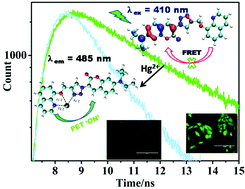Unusual absence of FRET in triazole bridged coumarin–hydroxyquinoline, an active sensor for Hg2+ detection†
Abstract
A triazole-bridged coumarin conjugated quinoline sensor has been ‘click’-synthesized by Cu(I) catalyzed Huisgen cycloaddition, and it exhibited high selectivity for toxic Hg2+. Surprisingly, no evidence of energy transfer from the quinoline moiety to coumarin has been found, substantiated by time-resolved fluorescence study. The possible binding mode of this sensor to Hg2+ has been established via NMR study, steady-state and time-resolved fluorescence spectroscopy, which is further supported by TDDFT calculations. The sensor has been found to be cell membrane permeable and non-toxic, and hence is suitable for intracellular Hg2+ detection.



 Please wait while we load your content...
Please wait while we load your content...